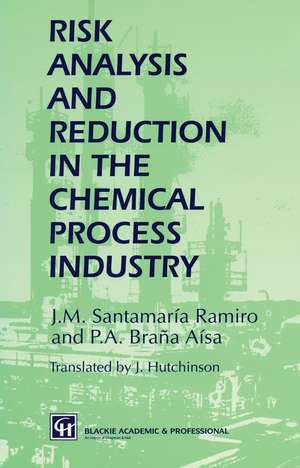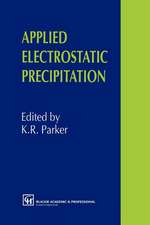Risk Analysis and Reduction in the Chemical Process Industry
Autor J. M. Santamaría Ramiro Traducere de J. Hutchinson Autor P. A. Braña Aísaen Limba Engleză Paperback – 22 noi 2012
Under these programmes existing and new processes are rigorously examined to determine the possible causes and consequences of failure, and the results used to improve the process to make failure less likely. Any process audit, aimed at improving safety or lessening the environmental impact, cannot be carried out using intuition or experience alone, so the discipline of risk analysis has grown as a collection of tools and methods which can be utilized to give a quantitative assessment of the risks involved in operating any given process. In this new book the authors present risk analysis and reduction in a clear and unified way, emphasizing the various different methods which can be used together in a global approach to risk analysis in the chemical process industries.
Originally conceived as a text book for graduate level courses in chemical engineering, the clear presentation and thorough coverage will ensure that anyone involved in risk assessment, environmental impact assessment or safety planning will find this book an invaluable source of reference.
| Toate formatele și edițiile | Preț | Express |
|---|---|---|
| Paperback (1) | 1221.07 lei 43-57 zile | |
| SPRINGER NETHERLANDS – 22 noi 2012 | 1221.07 lei 43-57 zile | |
| Hardback (1) | 1227.21 lei 43-57 zile | |
| SPRINGER NETHERLANDS – 30 noi 1997 | 1227.21 lei 43-57 zile |
Preț: 1221.07 lei
Preț vechi: 1489.10 lei
-18% Nou
Puncte Express: 1832
Preț estimativ în valută:
233.65€ • 244.60$ • 193.33£
233.65€ • 244.60$ • 193.33£
Carte tipărită la comandă
Livrare economică 07-21 aprilie
Preluare comenzi: 021 569.72.76
Specificații
ISBN-13: 9789401060714
ISBN-10: 9401060711
Pagini: 388
Ilustrații: XII, 370 p.
Dimensiuni: 155 x 235 x 20 mm
Greutate: 0.54 kg
Ediția:Softcover reprint of the original 1st ed. 1998
Editura: SPRINGER NETHERLANDS
Colecția Springer
Locul publicării:Dordrecht, Netherlands
ISBN-10: 9401060711
Pagini: 388
Ilustrații: XII, 370 p.
Dimensiuni: 155 x 235 x 20 mm
Greutate: 0.54 kg
Ediția:Softcover reprint of the original 1st ed. 1998
Editura: SPRINGER NETHERLANDS
Colecția Springer
Locul publicării:Dordrecht, Netherlands
Public țintă
ResearchCuprins
1 Introduction and general concepts.- 2 Hazard identification techniques.- 3 Consequence analysis: fires and explosions.- 4 Consequence analysis: release of hazardous substances.- 5 Vulnerability of persons and installations.- 6 Quantitative risk assessment.- 7 Risk reduction in the design of chemical plants.- 8 Risk reduction in operation and maintenance.- 9 Emergency planning.- 10 Legislation, standards and design codes.- Appendix: Some cases of industrial accidents.- A1 Explosions caused by runaway reactions: the accident in the Union Carbide facilities at Seadrift, Texas, 1991.- A1.1 Installation characteristics.- A1.2 Chronology.- A1.3 Causes of the accident.- A1.4 Design and safety considerations.- A1.5 Conclusions.- A.2 Accidents originating with operations of loading and unloading of containers: the accident in the EMPAK facilities, Deer Park, Texas, 1988.- A2.1 Installation characteristics.- A2.2 Chronology.- A2.3 Causes of the accident.- A2.4 Safety considerations and conclusions.- A3 Destruction of process and storage containers by vacuum: various cases.- A3.1 Case 1.- A3.2 Case 2.- A3.3 Case 3.- A4 Unconfined vapour cloud explosions. The case of the Nypro plant at Flixborough (United Kingdom).- A4.1 Installation characteristics.- A4.2 Chronology of the accident.- A4.3 Analysis of the causes of the accident.- A5 Toxic emissions caused by runaway reactions: the accidents of Seveso (Italy) and Bhopal (India).- A5.1 The dioxin emission at Seveso (1976).- A5.2 The escape of methyl isocyanate (MIC) at Bhopal (1984).- A6 References.


























